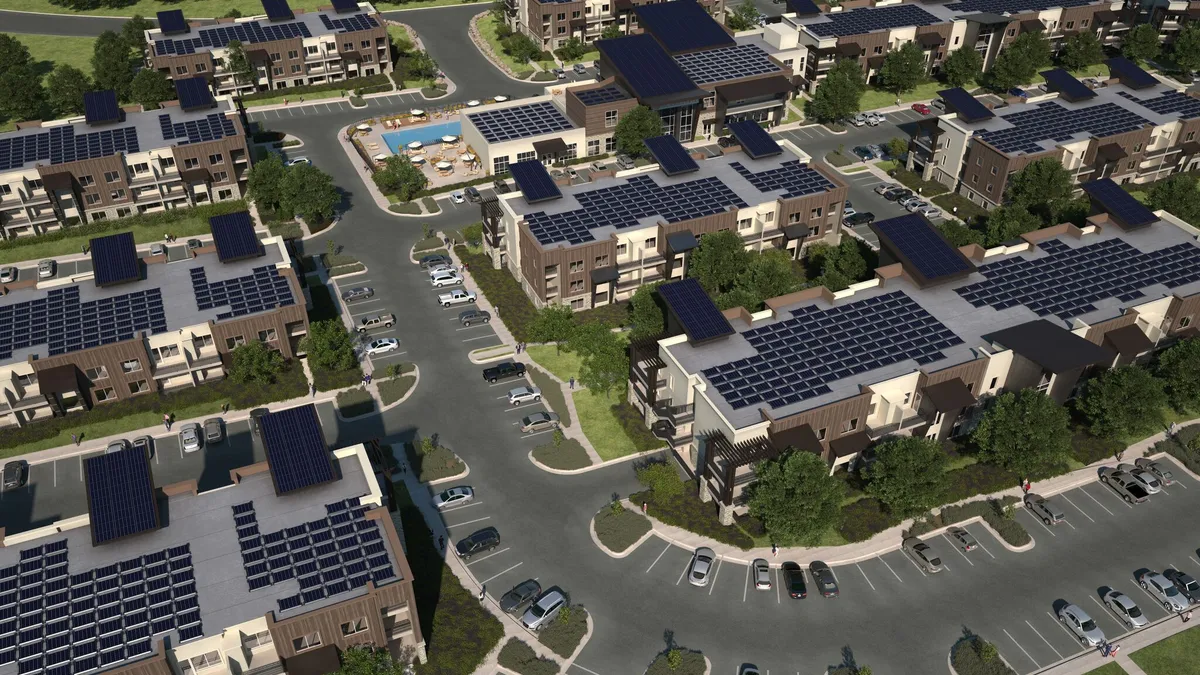Dive Brief:
- Rocky Mountain Power (RMP) seeks to turn distributed solar into solar-plus-storage grid assets in Utah, announcing on Thursday a partnership between battery manufacturer sonnen and Utah contractor ES Solar to retrofit thousands of solar homes.
- Following the success of the Soleil Lofts development, a housing community built to be accessed daily by the utility to help provide flexibility to grid management, RMP is offering incentives for its existing 50,000 solar customers in Utah to add a battery system that can work with sonnen's virtual power plant software. The Wattsmart Battery Program is expected to increase distributed power capacity that RMP can dispatch in the same way that capacity from the solar-plus-storage assets from Soleil Lofts were used in the grid.
- The utility has also filed a version of the incentive program in Idaho and is evaluating it for all six Western states where its parent company, PacifiCorp, operates. The program launched in Utah in 2021 provides upfront incentives and ongoing bill credits for participation.
Dive Insight:
Utilities have announced a string of programs in recent years to work with solar and storage developers and control behind-the-meter products during times of peak energy usage.
While RMP plans to add thousands of megawatts of renewables in the near future, the utility has been working for years with sonnen to establish a grid product that would utilize distributed resources on the grid as well, said Bill Comeau, RMP's vice president of customer experience.
The program connects distributed resources "directly into our energy management system ... providing grid support, voltage support, [and] frequency response help" by dispatching into the Western grid when there are issues, Comeau said.
According to the Utah Wattsmart battery incentive program, RMP can make daily use of customer-sited batteries from March through October, and will only use the storage systems in November through February for grid emergencies.
"What you've seen in so many other states ... what could be a great innovation gets squashed or delayed 10 years. Sonnen has witnessed this now so many times across this country, it's been so disheartening," Blake Richetta, chairman and CEO of sonnen, told Utility Dive. "This is what happens when a utility actually is able to work great with regulators and we build a platform and we just do it. And now somehow we're years ahead of my home state of California."
In California, Sunrun has proposed similar virtual power plants, specifically in Los Angeles, hoping to create a proof of concept for wider use of distributed resources in the grid. However, regulators are working on several dockets to address utility concerns regarding the addition of distributed resources and the state legislature earlier this year considered a bill that solar advocates warned would "kill" rooftop solar in the state.
Currently, sonnen is the sole approved battery provider for the Utah program, as the only battery manufacturer approved to interact with its own virtual power plant software, but the program is meant to include other battery providers as well, Comeau said.
The sonnenCore is the product most often sold into the Wattsmart program today, according to Richetta. About 208 sonnenCores, which provide about 10 kWh each, would provide the utility with 1 MW of dispatchable power capacity.
And expanding from the nearly 6 MW Soleil lofts project to this more inclusive program could bring more than 100 MW of dispatchable clean energy into the grid, Comeau said.
RMP worked closely with ES Solar, a solar developer that has reimagined its sales pitches to match the grid products that are available in Utah, to collaborate on program offerings for the harmonization of solar into the greater grid operation. "They have rebranded entirely around solar-plus-battery, more specifically going back to existing solar and adding these smart batteries," Richetta said, adding that ES Solar has sold a significant portion of batteries in this program.
Richetta hopes RMP's playbook for collaborating with solar and storage developers will be copied by others, now that the partnership has scaled up from the Soleil lofts development in Salt Lake City.
Other states have been working to encourage distributed energy development, particularly by removing incentives from utilities that would otherwise prioritize building their own generation.
"We worked really hard on the performance-based regulation framework here in Hawaii to sort of remove those incentives and to levelize the playing field," Grace Relf, senior utility analyst at the Hawaii Public Utilities Commission, said. Hawaii regulators added incentives to add distributed renewable energy online quickly.
"On the distributed energy resource side we're aiming to really standardize communications up to the national standards and sort of create a level playing field for different market players so that there isn't really a competitive advantage for certain developers or entities just because they're working with a utility already," Relf said.
Distributed resource planning proceedings around the country are looking to solar-plus-storage as a “really good option to replacing other types of necessary grid upgrades,” from upgrading transformers to transmission line sizes, according to Rick Gilliam, Vote Solar’s senior regional director of DER regulatory policy.
“Hopefully [RMP] will be able to find a balance between the customer getting a benefit on the customer’s own energy use and patterns of consumption at the same time as providing that flexibility, [that] grid management opportunity from the utility’s perspective through this incentive,” Gilliam said.















